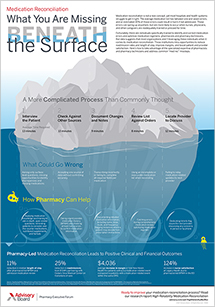Auto logout in seconds.
Continue LogoutAs doctors, it's easy to focus on the medical advice you give patients and overlook how those recommendations are received, Sachin Jain, president and CEO of CareMore Health System, writes in Forbes.
Feb. 19 webconference: How to win physician buy-in for your patient experience efforts
Drawing on his experience as a physician, Jain outlines six common patient misconceptions about medicine and what doctors can do to correct them.
1. Correlation equals causation. This, Jain writes, is a common misconception. Jain recalls an instance when a patient incorrectly believed the diabetes treatment metformin caused his blood sugar to spike.
Jain explains that "metformin takes time to reach therapeutic levels and had nothing to do with the rise in his blood sugar." So, while there was a correlation between the medication and the rise in his blood sugar, "that correlation did not mean that the medication caused the rise," Jain writes.
To explain the difference to the patient, Jain cited a "memorable article" published in the New England Journal of Medicine in which the authors observed countries where people consume a lot of chocolate have more Nobel laureates. However, the findings, did not mean that the author "found a direct link between eating chocolate and winning the Nobel Prize—which we would call causation."
2. 'Natural' treatments are superior to chemical. The meaning of the word "natural" is another common misconception among patients, Jain writes. Some patients assume that "natural" means better, and this belief can lead patients to forego important medical interventions.
While some natural treatments might be effective, "[t]he truth is, thanks to medications created in laboratories, people are living longer, healthier lives than ever before," Jain writes.
So when Jain's patients request a "natural cure" he responds to them in the way he believes "every physician should." He paraphrases that response, writing, "I'm only interested in prescribing therapies that have been proven to work. This is called evidence-based medicine, and it's one of the main reasons the average lifespan in America has increased from 69.7 years in 1963 to about 78 years today."
3. Medication is always the answer. On the other hand, Jain writes there are patients who expect medication whenever they see a clinician, and these patients need to understand that in some cases, "[d]oing nothing is sometimes better than doing something."
He recalls a patient who came in with a cold. Jain originally "suspected strep throat," but when the test for the infection "came back negative," Jain recommended that the patient go home and rest, drink fluids, and take over-the-counter medication for her fever, Jain writes.
Then the patient asked, "'Aren't you going to give me an antibiotic?'"
Jain explained that, since she didn't have a bacterial infection, antibiotics would not help. "Moreover, taking antibiotics unnecessarily can have harmful effects," Jain writes, and "when we look at population health, over-prescription of antibiotics is causing bacteria to become resistant to them."
Jain followed up with the patient a week later and found that her cold had passed.
4. All medications are created equal (when it comes to dosages). When patients do receive medication, many think that "when it comes to dosages, all medicines are alike—that 10 milligrams of medicine A is similar to 10 milligrams of medicine B," Jain writes.
While it's "understandable" that patients would make that assumption, Jain writes that potency is "drug-specific," meaning that each medication has a unique dose that makes it effective. Additionally, "[D]rug dosing is patient and condition-specific," Jain writes. "In fact, different drugs used to treat the exact same ailment are frequently prescribed in very different dosages."
5. Splitting doses make drugs last longer. During his residency, Jain prescribed a patient with Type 2 diabetes a medication to lower blood sugar—but the patient's blood sugar levels started rising. Before looking into a different treatment regimen, Jain asked the patient if there were other factors that could be causing the spike.
The patient "teared up and said, 'I couldn't afford all those pills, Dr. Jain. So I broke them in half to make them last longer,'" Jain writes.
According to Jain, "In an era of rising drug costs, higher deductibles, and Medicare donut holes," it's "not uncommon" for patients to split doses to make medication last longer.
However, patients often fail to realize that medication is truly effective when taken as prescribed. So, if the medication is split in half, that doesn't mean it "will be half as effective; more likely, it will have no effect at all," Jain writes.
To prevent his patient from splitting doses, Jain found a generic medication that the patient could access at a low-price at a local pharmacy.
6. Generic is worse than brand drugs. A lot of patients assume that generic drugs are less effective than brand name drugs, Jain writes. One complaint that Jain hears "frequently" from patients "is that they need to take more generic pills to get the same effect that they would get out of a brand name drug," he writes.
But, that's not the case. According to Jain, FDA has a "stringent approval process for generic drugs," which ensures that generic medications are "the same as brand-name medicine in dosage, safety, effectiveness, strength, stability, and quality, as well as in the way it is taken and should be used."
In order to address the misconceptions, physicians have to be "direct" in telling patients that "[g]eneric drugs are the same as brand name drugs," Jain writes. "In most cases, it's that simple."
While there are few instances where patients might fare better with a brand-name medication than a generic, Jain says the most common difference between the two is that generics are "more affordable."
"The common nature of these misconceptions suggests we have a long way to go in our approach to educating our patients about their diseases and their treatments," Jain writes.
Jain notes that he sees these teaching moments as part of "my job as a physician [to learn] about how patients receive information and adapting my style and approach to theirs," he writes (Jain, Forbes, 2/4).
Feb. 19 webcon: How to win physician buy-in for your patient experience efforts
Learn about physicians’ unique role as the "influencer-in-chief" of patient experience and how you can partner with physicians to drive patient experience initiatives.
Don't miss out on the latest Advisory Board insights
Create your free account to access 1 resource, including the latest research and webinars.
Want access without creating an account?
You have 1 free members-only resource remaining this month.
1 free members-only resources remaining
1 free members-only resources remaining
You've reached your limit of free insights
Become a member to access all of Advisory Board's resources, events, and experts
Never miss out on the latest innovative health care content tailored to you.
Benefits include:
You've reached your limit of free insights
Become a member to access all of Advisory Board's resources, events, and experts
Never miss out on the latest innovative health care content tailored to you.
Benefits include:
This content is available through your Curated Research partnership with Advisory Board. Click on ‘view this resource’ to read the full piece
Email ask@advisory.com to learn more
Click on ‘Become a Member’ to learn about the benefits of a Full-Access partnership with Advisory Board
Never miss out on the latest innovative health care content tailored to you.
Benefits Include:
This is for members only. Learn more.
Click on ‘Become a Member’ to learn about the benefits of a Full-Access partnership with Advisory Board
Never miss out on the latest innovative health care content tailored to you.


